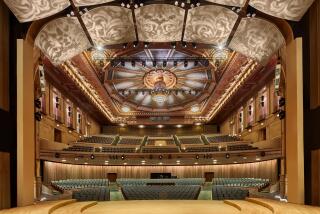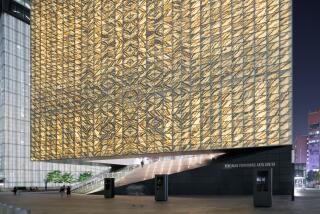The stage is reset
- Share via
NEW ORLEANS — New Orleans, hammered by Hurricane Katrina 3 1/2 years ago and still lurching toward a full recovery, received a helping hand -- and voice -- Saturday.
Superstar tenor Placido Domingo culminated a 10-day grand reopening of the city-owned Mahalia Jackson Theater for the Performing Arts, which has undergone $22 million in renovations after being severely damaged by the hurricane flood waters. The arts center had been closed since it took on 14 feet of water in the 2005 storm and left the New Orleans Opera, Louisiana Philharmonic Orchestra and New Orleans Ballet Assn. without a home.
“It’s very, very encouraging after what happened here to see that they can do this,” Domingo , L.A. Opera’s general director, said backstage after Saturday’s nearly 3 1/2 -hour concert of opera arias, many attuned to the theme of art’s ability to inspire and endure.
“This is very special for me,” said Domingo, whose fundraising efforts and long connection to the city were recognized with a half-dozen awards and proclamations, chief among them the naming of the Mahalia Jackson Theater’s stage after him. “I sang here three years ago to help raise money for this theater, but I used to sing over there -- so many performances,” he said, gesturing toward the long-dark Municipal Auditorium adjacent to the Mahalia Jackson. Domingo made several key appearances here early in his career -- including his first “La Traviata” -- four decades ago, well before his was a household name.
“To come back now and see everything that is possible,” Domingo said, “it’s really beautiful.”
The performance by Domingo, baritone Mark Rucker, mezzo-soprano Kristine Jepson, soprano Sondra Radvanovsky plus two other singers, the Louisiana Philharmonic Orchestra and the New Orleans Opera Chorus was the finale of a series of benefit concerts marking the 36-year-old theater’s return.
The show, which attracted a sellout crowd to the 2,100-seat theater with tickets ranging from $45 to $1,000, heard Domingo sing eight arias by Wagner, Massenet, Sorozabal and others. The night was capped by his duet with New Orleans soprano Sarah Jane McMahon in “Tonight” from Leonard Bernstein’s “West Side Story.”
Beyond christening the revitalized facility, Domingo crowned what many in New Orleans see as a sign of the embattled region’s soul being restored after a beating from nature and governmental bureaucracy.
In many cities, a performing arts center is a gathering place for the well-to-do, a nexus for the privileged to celebrate art forms that often have little resonance with the general population. But in a city that gave birth to jazz and historically has been a melting pot, culture is serving as a rallying point rather than a dividing line.
“The return of this theater seems to have done something to the city,” Mayor C. Ray Nagin said Friday. “I see more people being more positive, the local media reports having a more positive tone. Something clicked because of its connection with this city’s culture. It’s bringing people closer and closer.”
That appears true of the three main homegrown arts organizations that use it.
“This sends a signal that the city is not only back to where it was before, but it’s coming back better than before,” said Jenny Hamilton, executive director of the New Orleans Ballet Assn., which presents touring ballet companies and partners with various local organizations to provide free dance classes for youths.
“This is amazing,” said Tanya Netter, a division head at Lafayette Charter School following a concert the Louisiana Philharmonic Orchestra gave Thursday for several hundred elementary school students from the region. “I didn’t even realize until I stepped inside that this is the same place my daughter came for her dance recitals for about 10 years.”
The ballet, opera and orchestra each have struggled to hold onto subscribers by continuing with their seasons in a hodgepodge of churches, college auditoriums and whatever other public spaces they could rent post-Katrina.
“It’s been a long road,” said Sharon Litwin, senior vice president of external affairs for the Louisiana Philharmonic Orchestra. “It’s been almost 3 1/2 years, and in that time this orchestra has played in something like 22 venues.”
The arts community has struggled to recover and, like the rest of the city, has found the Federal Emergency Management Agency both a help and a hindrance. In the case of the Mahalia Jackson Theater, FEMA’s estimates of what was needed to fix it changed dramatically.
“We thought optimistically that this theater might come back fairly quickly after the storm,” said Robert Lyall, New Orleans Opera’s artistic director and conductor for most of Saturday’s concert, except for a few numbers when he handed the baton over to Louisiana Philharmonic Orchestra music director Carlos Miguel Prieto. “Then we got these wildly ranging estimates of what it would cost. At first it was a few hundred thousand dollars when they thought that all it needed was some new paint and wallpaper. Then it went to $3 million and $7 million and $9 1/2 million. Every time we’d meet with another FEMA team, the cost would go up.”
Cynthia Sylvain-Lear, the city’s deputy chief administrative officer, one of the driving forces behind the Mahalia Jackson renovation, said, “There were some people from FEMA who actually said all we needed to do was get the electricity back on, dry out the walls and wipe down the seats. . . . No way.”
Although the Mahalia Jackson Theater, one of about 500 city-owned facilities that suffered major storm damage, didn’t have extensive structural damage, most of the equipment that controlled the theater’s operation were in the basement, which was flooded.
The first hurdle toward bringing the Mahalia Jackson Theater back to life was getting FEMA to commit to restoration funds.
In the summer before Katrina hit, the theater had been undergoing some repairs on its electrical system -- but because FEMA disallows any projects that are considered under construction, the agency initially rejected the city’s request for financial help.
Adding to the bureaucratic challenges, Nagin said he decided early on that the city’s primary performing arts facility needed more than a return to its pre-Katrina state. After more than three decades of performances, the venue needed various upgrades to its infrastructure.
“We had so many priorities after Katrina,” Nagin said. “This all came about in phases. The city’s seawater system had to be cleaned up, citizens needed to move back in, public safety needed to be assured, and we had to return operations of schools and other things.
“But as soon as we got those plans going, I kind of realized something was really missing: It was the culture, and the music -- everything that makes New Orleans special.”
--
More to Read
The biggest entertainment stories
Get our big stories about Hollywood, film, television, music, arts, culture and more right in your inbox as soon as they publish.
You may occasionally receive promotional content from the Los Angeles Times.










